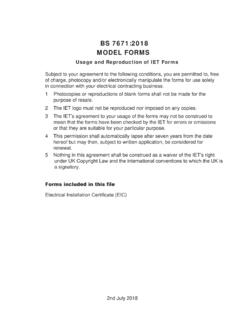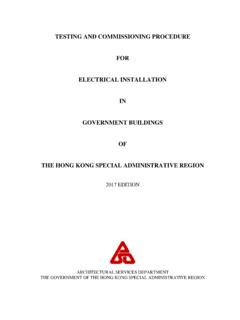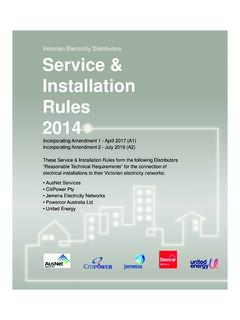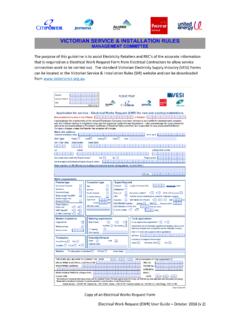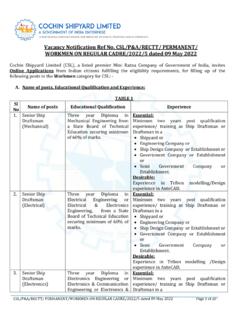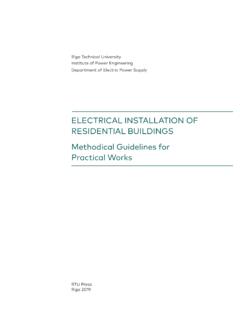Transcription of Module 24: The electrical installation - SAHITA
1 SAHITA 2012 1 | P a g e Module 24: The electrical installation Module Objectives By the end of this session, participants will understand: 1. The home inspector s limited but important role in checking electrical installations 2. The basics of electrical installations 3. What the home inspector should look out for in the different areas of the house and garden Module at a glance: Topic You will learn Electricity compliance - What the law says - About the limited but important inspection role of the home inspector. Basic information of a home electrical installation - About what electricity is. - How electricity is measured - How an electrical supply is installed to service a home. Home inspection and the electrical installation - What the home inspector should observe and report on concerning the electrical installation .
2 SAHITA 2012 2 | P a g e The electrical installation Home inspectors do not test the electrical installation of a house because the home inspector is not a licensed electrician. Likewise the home inspector does not issue a certificate of compliance (CoC) for the installation . This is a document which is required by law in South Africa, every time a property is sold (transferred) and every time an electrical installation is altered. In South Africa the seller normally takes responsibility for the issue of the CoC. The home inspector, on the other hand, usually works for the buyer. The Occupational Safety Act (85) of 1993 (updated 2008) requires that all house electrical installations must be installed and repaired under control of a registered electrician.
3 The Act also stipulates that the property owner must be in possession of a certificate of compliance for any changes to the wiring of the property. The information in this SAHITA Module is designed to give the home inspector a basic understanding of the electrical installation and also equip the inspector to report to the client on observable defects such as: Loose, exposed or dangerous wiring Dangerous, broken or illegal electrical distribution boards including the board at the swimming pool. Dangerous and illegal hot water geyser connections and earthing. Illegal live points in too close proximity to water in the bathroom or kitchen. However, it is still necessary for the professional property inspector (and useful for the property owner) to have a basic knowledge of electrical wiring and installations. This knowledge will enable the inspector to identify obvious existing problems and potential problems and advise the client accordingly.
4 SAHITA 2012 3 | P a g e Electricity basics Electric current is a movement or flow of electrically charged particles (electrons). In a typical modern house wiring system, electricity from a municipal supply enters the house via an underground cable; in older houses electricity is often supplied via overhead wiring from a municipal street pole. The power is distributed through the house via a distribution board (DB), which is equipped with circuit breakers (switches), to the various lighting and power circuits. The wiring system is earthed via an earth spike which is placed deep into the ground in accordance with the relevant regulations. The supply of electricity to South African houses is a nominal 230 volts of alternating current (AC).
5 The supply to all circuits in the house is also the nominal 230V, but the amp rating of the circuits will vary according to the amount of power each circuit is required to deliver. Most South African houses are supplied with single phase power. Three-phase electrical generation is common in industry and is also installed in homes which have a high electricity consumption requirement. A three-phase system is generally more economical, because it uses less conductor material than single phase, to transmit an equivalent amount of power. An electrical installation The DB board (distribution board) is the point of entry of electricity into the house. In older homes, the DB board is often still a surface-mounted cast iron box containing a number of ceramic or porcelain fuses linked to each circuit. Circuits are loops of conductor material (wiring) which supplies electricity to different areas of the house.
6 With these old DB boards, the function of the fuses is to prevent circuit overload the fuse is the weakest point and the fuse wire/metal strip is designed to fail when the amperage over the circuit is exceeded. When the circuit is overloaded, the fuse wire/metal strip heats up and fails, thereby breaking the circuit. The blown fuse needs to be replaced with one of the same amperage. SAHITA 2012 4 | P a g e If the cause of the problem is a power surge, replacing the fuse should sort out the problem. However, if there is a fault is in the circuit, or the circuit continues to be overloaded, then the fuse will continue to blow until the problem is corrected.. New installations of a DB or a sub-DB in the garage (for example) must be installed in compliance with SANS 10142 which specifies appropriate circuit breakers, together with an earth leakage unit.
7 A DB must be located between and from the floor. Like most electrical regulations this height regulation is simple common sense as regards safety: The DB should not be too low (within reach of a small child) and neither should it is located too high (making it difficult for the average adult to easily reach in the event of an emergency). A modern DB board contains a sensitive earth leakage unit that trips the entire system immediately a fault develops between the neutral and the earth. The various circuits in a house have different amp ratings according to the amount of power they are required to deliver. Light circuit breakers should be 10 amps, while plug point circuit breakers will generally be 20 amps. Electricity is measured in various units Amperes (A). The number of amps defines the volume of electrical current flowing through a circuit.
8 A usual house DB will have a rated main circuit breaker ( main switch ) of 60A. Light circuits are normally 10A, geyser circuits 15/20A, plug circuits 15/20A, stove circuits 35A. The rating of the circuit breakers (including the mains switch) is designed to prevent overload, and the consequent overheating and fire risk which is likely to occur if too much power is drawn through the system. In more modern houses the old porcelain/ceramic push in fuses have been replaced with circuit breakers which work on the same principle the circuit breaker is rated for a particular amperage and is designed to trip (switch off) when the circuit is overloaded. SAHITA 2012 5 | P a g e Milliamp (mA) is 1000th of an amp. An earth leakage unit normally has a sensitivity of 30mA. The earth leakage will trip if the leakage of power from the neutral to the earth is greater than 30mA.
9 This is especially designed to prevent people getting lethal shocks. (A shock occurs when a person becomes part of the earthing system and current flows from the live wire, through the person and into the ground.) Resistance (R) is measured in ohms and is a measure of the opposition to electrical flow for instance from the conductor wire itself, and mainly from the light bulb or appliance. Volt (V) is a measure of the electrical potential between two points. An electrical potential of 1V will push 1A of current through a 1 ohm resistance load. An analogy: Voltage is similar to water pressure and amperes measures the actual flow (units flowing through the system). The electrical supply to a South African home is 230V (nominally 220V). Watt (W) is the standard measurement for the consumption of electrical power by an appliance or a light: 1W = 1A of current flowing at 1V.
10 Therefore W = V X A. For instance a 100W light bulb draws approximately (100=230 X approx.). Kilowatt (kW) is 1000W. The connected load of an electrical installation is reckoned in kW. Stove: 8kW; geyser: 3kW; 12 plug sockets: 6kW; 20 lights: Kilowatt-hours (kWh) is the measurement of electrical consumption. For example if you leave five 100W lights on for 10 hours you will use: 5 X 100 X 10 =5 000 watt hours or A 2000W electrical motor running for 1 hour would use: 1X2000 = 2kWh. The regulations governing electrical installations (SANS 10142) specifies the cross-section of the connecting and circuit conductors ( wires ). To prevent overheating and failure, the correct thickness of conductor wire must be used for wiring circuits. The thickness required depends on the connected load to be carried by the conductor (wire). The wire thickness used for connections must be correct for the power supplied.
